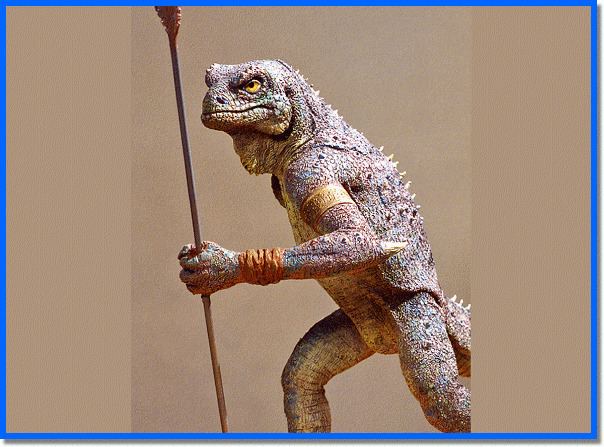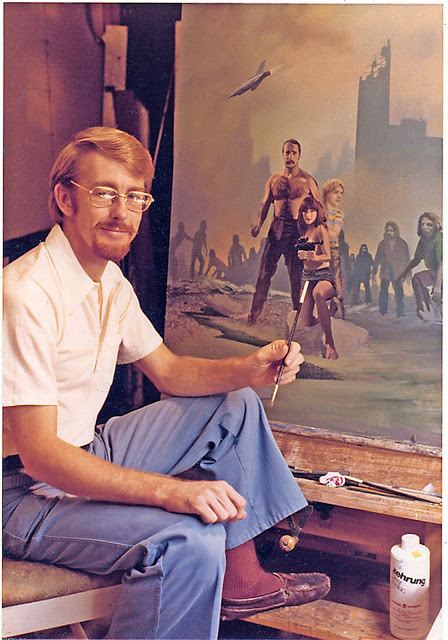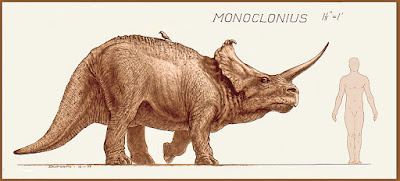Nationality American Citizenship United States | Name Jim Danforth Role Animator | |
 | ||
Movies The Aftermath, Fantastic Dinosaurs of the Movies Similar People Val Guest, George Pal, George Tomasini, Charles Beaumont, Ben Hecht Nationality American Born July 13, 1940 (age 83) United States | ||
West of Kashmir fx clips Jim Danforth
Jim Danforth (born 1940) is a stop-motion animator, known for model-animation and matte painting. Danforth is known for his work on When Dinosaurs Ruled the Earth (1970), a sequel of sorts to Ray Harryhausen's One Million Years B.C. (1967). Danforth later went on to work with Harryhausen on the film Clash of the Titans (1981), in which he was mainly responsible for the animation of the winged-horse Pegasus.
Contents
- West of Kashmir fx clips Jim Danforth
- Jim danforth robot wars
- Career
- 1960s
- 1970s
- 1980s
- 1990s
- Documentaries
- References

Danforth has been twice nominated for an Academy Award for Visual Effects for George Pal's 7 Faces of Dr. Lao (1964), and for When Dinosaurs Ruled the Earth (1970).

Jim danforth robot wars
Career

Danforth's first job in the professional film industry was as a sculptor and artist for clay-animation pioneer Art Clokey, who had previously produced the beloved children's series Gumby during the 1950s.
1960s

Danforth was then hired by a company known as Projects Unlimited and assisted a team of effects technicians on George Pal's celebrated 1960 feature-length science-fiction film, The Time Machine (1960), an Oscar winner for visual effects for that year.
Working with two other animators and a team of artists and technicians at Projects Unlimited, Danforth did the model-animation effects for the fantasy film Jack the Giant Killer (1962), a 7th Voyage of Sinbad knock-off, which starred Sinbad's Kerwin Mathews and Torin Thatcher.
Danforth continued at Projects Unlimited to animate the dragon in The Wonderful World of the Brothers Grimm (1962).
In 1963, Danforth was hired by special visual effects pioneer Linwood G. Dunn to animate miniature versions of the comedians in the finale-sequence of Stanley Kramer's all-star comedy, It's a Mad, Mad, Mad, Mad World. He also animated the miniature firetruck ladder for that sequence.
Danforth returned to Projects Unlimited when they were hired to produce effects and create monsters for the original The Outer Limits TV series during the mid-60s. Some of Danforth's brief effects animation can be seen with the plant creature at the end of the episode entitled "Counterweight". He also animated the title alien insects for the episode "The Zanti Misfits". In 1964, Danforth worked as an uncredited prop maker for 'Star Trek's first pilot, "The Cage."
While still at Projects Unlimited, Danforth was again hired by George Pal to do model animation for 7 Seven Faces of Dr. Lao, Tony Randall's multi-role tour-de-force and Randall's favorite film (1964). Danforth garnered his first Oscar nomination for his work animating the shape-shifting Loch Ness Monster near the end of the film. (The film lost to Disney's Mary Poppins.)
In the late 1960s, Danforth aided fledgling film maker Dennis Muren (who later became head of George Lucas's Industrial Light and Magic (ILM) special effects facility, and won several Oscars of his own) by assisting with the making of a 16 mm short film titled The Equinox... A Journey into the Supernatural, later expanded by producer Jack H. Harris into a feature film entitled Equinox in 1970. (That film has also been known on VHS video under the title "The Beast".) Danforth appeared as several 'extras' in the film and lent a hand animating cells, painting mattes, and constructing sets and equipment, but did none of the film's stop-motion animation (handled by Dave Allen and Dennis Muren). (Photo of Jim Danforth and matte painting from "Equinox" copyright 1965, 2006 Susan Turner)
1970s
Looking for a sequel for its hit 1967 Ray Harryhausen film One Million Years, B.C., and unable to hire Harryhausen again (who was working on The Valley of Gwangi at the time) England's Hammer Films hired Danforth to animate the dinosaurs in When Dinosaurs Ruled the Earth (1970). Danforth refined the ability of his dinosaur models to realistically convey emotions, and developed the first use of blurring the animated models by using thin wires to move parts of them during the exposure of each frame. The film merited Danforth a second Oscar effects nomination, but lost to Disney's Bedknobs and Broomsticks (1970).
During the early 1970s Danforth did pre-production special effects tests for film producer Harry Saltzman on the unmade film Cold War in a Country Garden (a.k.a. The Micronauts). This proposed film which dealt with miniaturised spies was part of what film historian John Brosnan calls the "shrunken man" cycle of films best exemplified by the 1966 film Fantastic Voyage. Danforth's work "involved compositing live action elements with glass painting during a camera tilt down."
In the early 1970s, Danforth was hired to do a model animation sequence of a "beetle man" for the underground feature film, Flesh Gordon (1974). Embarrassed by the film's low-brow style of semi-porn comedy, Danforth stipulated that his name not be used. The film's producer, Howard Ziehm, gave him a credit anyway, spelled backwards.
Danforth then briefly joined with producer-actor (and, later, director) Dan O'Bannon and first-time director John Carpenter to provide some matte paintings for the independent counter-culture science fiction cult-hit comedy, Dark Star (1975), another project started as short film and expanded by producer Jack H. Harris into a feature film, which was nominated for an effects Oscar (losing to Albert Whitlock's polished work on The Hindenburg).
In 1975, due to his dislike of the screen play, Danforth rejected a personal carte blanche offer from Dino de Laurentiis to create a stop-motion sequence for the De Laurentiis remake of King Kong, but accepted a contract with Universal to design creatures and animation for their competing film The Legend of King Kong (later shelved).
When the De Laurentiis King Kong was awarded an Oscar for best visual effects, despite the fact that the effects nominating committee for the Academy of Motion Picture Arts and Sciences had made no such recommendation (and the bulk of effects were actually shots of Rick Baker in an ape suit on a miniature set), Danforth quit the committee and the Academy in protest. Danforth's publicized action was popular with film fans, but disturbed those in Hollywood who wanted the status quo to remain unchallenged.
While Danforth was writing, designing effects, directing, and co-producing his film Timegate (later shelved), Star Wars forever revolutionized the film industry.
1980s
In 1979, Danforth was hired, along with Rick Baker, to design effects for Edward Pressman's proposed production Conan. This film mutated into a different version (Conan the Barbarian, 1982), with which neither Danforth nor Baker were involved. Although Danforth was not firstly involved on the visual effects of the John Milius project, he was hired to paint a matte shot during postproduction. He executed a matte painting for the penultimate shot of the film, showing Conan and the princess walking down toward a painting of a landscape valley. Danforth also provided a matte painting for the little-known film, The Day Time Ended.
Next, Danforth was hired to create the visual effects for the spoof comedy starring ex-Beatle Ringo Starr, Caveman (1981). Danforth designed the dinosaurs and directed the live-action scenes in which the dinosaurs would appear, but the hands-on animation was done by David Allen, Randy Cook and Pete Kleinow. Danforth left the project "about two-thirds of the way."
Then Danforth returned to England to assist on Ray Harryhausen's last film, Clash of the Titans (1981). Danforth animated portions of the Kraken and the two-headed wolf sequences and most of the Pegasus scenes.
In the mid-1980s, Danforth was hired to do the "thought-box" matte shots for Danforth-fan Mike Jittlov's tour-de-force first feature film, The Wizard of Speed and Time (released to theaters in 1987 and video in 1989), based on Jittlov's astounding 1980 short film of the same name. Danforth, and his wife appear briefly on camera as two space shuttle astronauts in orbit during the film's final effects extravagaza sequence, and also appear in a sequence spoofing the Directors Guild.
During the late 1980s and early 1990, Danforth was involved with the John Carpenter films Body Bags, They Live, Prince of Darkness, and Memoirs of an Invisible Man, supplying, depending on the productions's needs, matte paintings, optical effects, stop motion animation, and second-unit direction.
1990s
Throughout the 1990s, Danforth has kept a somewhat lower profile, mainly providing matte paintings and supervising composite matte work on scores of films, a continuation of his matte work on films going back into the 1960s. Comprehensive lists of them can be found on the Internet Movie Database, a link for which is below.
Danforth resides and operates professionally in the vicinity of Los Angeles, where he focuses on creating fine art and paintings within the fantasy genre.
In the early 2000s, he released his detailed autobiography of his personal life and film career, "Dinosaurs, Dragons, and Drama", in two volumes on two computer-data DVDs, loaded with rare photos and technical information. The two volumes are still available via various sales websites. (He has consistently declined to publish the material in the more generally accessible printed book form for economic reasons.)
Documentaries
Danforth appeared in the documentary film The Fantasy Film Worlds of George Pal (1985) (Produced and directed by Arnold Leibovit).
